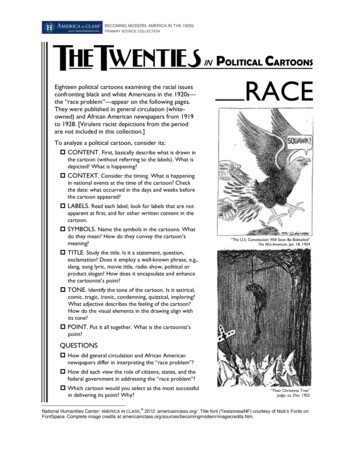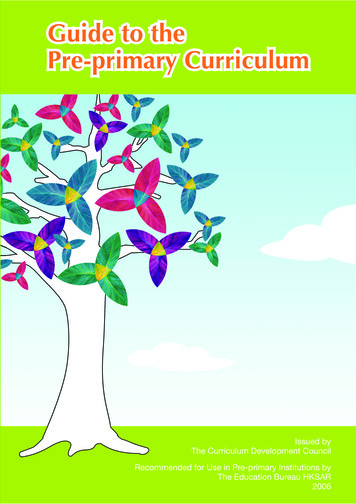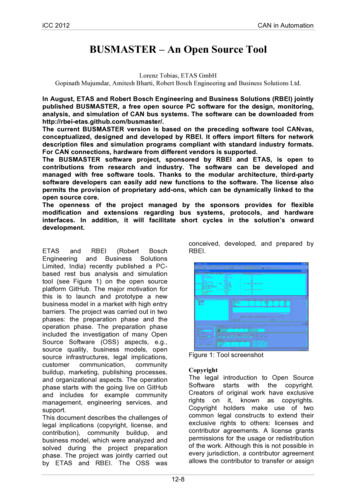
Transcription
BECOMING MODERN: AMERICA IN THE 1920SPRIMARY SOURCE COLLECTION*THETWENTIESEighteen political cartoons examining the racial issuesconfronting black and white Americans in the 1920s—the “race problem”—appear on the following pages.They were published in general circulation (whiteowned) and African American newspapers from 1919to 1928. [Virulent racist depictions from the periodare not included in this collection.]INPOLITICAL CARTOONSRACETo analyze a political cartoon, consider its: CONTENT. First, basically describe what is drawn inthe cartoon (without referring to the labels). What isdepicted? What is happening? CONTEXT. Consider the timing. What is happeningin national events at the time of the cartoon? Checkthe date: what occurred in the days and weeks beforethe cartoon appeared? LABELS. Read each label; look for labels that are notapparent at first, and for other written content in thecartoon. SYMBOLS. Name the symbols in the cartoons. Whatdo they mean? How do they convey the cartoon’smeaning?“The U.S. Constitution Will Soon Be Bobtailed”The Afro-American, Jan. 18, 1924 TITLE. Study the title. Is it a statement, question,exclamation? Does it employ a well-known phrase, e.g.,slang, song lyric, movie title, radio show, political orproduct slogan? How does it encapsulate and enhancethe cartoonist’s point? TONE. Identify the tone of the cartoon. Is it satirical,comic, tragic, ironic, condemning, quizzical, imploring?What adjective describes the feeling of the cartoon?How do the visual elements in the drawing align withits tone? POINT. Put it all together. What is the cartoonist’spoint?QUESTIONS How did general circulation and African Americannewspapers differ in interpreting the “race problem”? How did each view the role of citizens, states, and thefederal government in addressing the “race problem”? Which cartoon would you select as the most successfulin delivering its point? Why?*“Their Christmas Tree”Judge, ca. Dec. 1922National Humanities Center: AMERICA IN CLASS, 2012: americainclass.org/. Title font (TestarossaNF) courtesy of Nick’s Fonts onFontSpace. Complete image credits at dits.htm.
“The Missionary’s Sons”Chicago Daily Tribune, September 30, 1919Cartoonist: John T. McCutcheonI.W.W.: International Workers of the WorldEast St. Louis race riots: May/July 1917Chicago race riots: July/August 1919Washington [DC] race riots: July 1919Boston police strike: Sept. 1919Omaha lawlessness: Sept. 1919The three figures on the European continent are caricatures of a Russian, a Greek, and a Spaniard, probablyreferring to the Russian Revolution and civil war, the Greco-Turkish War, and the 1919 Barcelona workers’ general strikeReproduced by permission of the Chicago Tribune. Digital image courtesy of ProQuest Historical Newspapers.National Humanities Center Political Cartoons of the 1920s: Race—Black & White in America
“They’re Learning”New York World, September 30, 1919Cartoonist: Rollin KirbyLenine: Vladimir Lenin, Bolshevik leader of the 1917 Russian Revolution.Omaha, Nebraska, race riot, Sept. 28-29, 1919.Permission pending identification of copyright holder. Digital image from microfilm.National Humanities Center Political Cartoons of the 1920s: Race—Black & White in America
“At the Other End of the Lyncher’s Rope”Des Moines Register, Iowa, September 30, 1919Cartoonist: Jay N. “Ding” Darling.While the sketch quality of the image suggests the cartoon was not published,it did appear on the front page of the Sept. 30, 1919, edition of the Des Moines Register.Reproduced by permission of the Jay N. “Ding” Darling Wildlife Society. Digital image courtesy of the University of Iowa Libraries.National Humanities Center Political Cartoons of the 1920s: Race—Black & White in America
“They Have Ears but They Hear Not”[Psalm 135:17]The Crisis, November 1920African American periodical. Cartoonist: Albert Alex Smith.Reproduced by permission of the Modernist Journals Project, Brown University and the University of Tulsa.National Humanities Center Political Cartoons of the 1920s: Race—Black & White in America
National Humanities Center Political Cartoons of the 1920s: Race—Black & White in AmericaReproduced by permission of The Afro-American Newspapers Archives & Research Center. Digital image courtesy of ProQuest Historical Newspapers.Despite widespread support for a “soldier’s bonus” for World War I veterans, Congress delayed legislation until 1924.African American newspaper. Cartoonist: John Good [—].The Afro-American, Baltimore, November 11, 1921Untitled
Permission request in process. Digital image courtesy of ProQuest Historical Newspapers.“If the Daily Press Dared Tell the Truth”The Chicago Defender, July 1, 1922African American newspaperNational Humanities Center Political Cartoons of the 1920s: Race—Black & White in America
Reproduced by permission of The Afro-American Newspapers Archives & Research Center. Digital image courtesy of ProQuest Historical Newspapers.“Cast Overboard”The Afro-American, Baltimore, Dec. 15, 1922African American newspaper. Cartoonist: John Henry Adams.G.O.P.: Republican Party (“Grand Old Party”).Dyer Anti-Lynching Bill: Republican bill introduced in the U.S. Congress in 1918 to make lynching a federal crime;passed in the House in 1922; blocked in the Senate by southern Democrats, after which the Senate Republicancaucus vote, on December 2, to abandon the bill in that session of Congress.National Humanities Center Political Cartoons of the 1920s: Race—Black & White in America
“Their Christmas Tree”Judge, Dec. 16, 1922as reprinted in The Afro-American, Baltimore, Dec. 29, 1922Permission pending identification of copyright holder. Digital image courtesy of ProQuest Historical Newspapers.National Humanities Center Political Cartoons of the 1920s: Race—Black & White in America
“Great Scot! What Have I Done?”The Chicago Defender, February 17, 1923African American newspaper. Cartoonist: Leslie Rogers.Permission request in process. Digital image courtesy of ProQuest Historical Newspapers.National Humanities Center Political Cartoons of the 1920s: Race—Black & White in America
“The South Will Soon Be DemandingRestriction of Migration of Its Labor”Chicago Daily Tribune, May 10, 1923Cartoonist: John T. McCutcheonReproduced by permission of the Chicago Tribune. Digital image courtesy of ProQuest Historical Newspapers.National Humanities Center Political Cartoons of the 1920s: Race—Black & White in America
Reproduced by permission of The Afro-American Newspapers Archives & Research Center. Digital image courtesy of ProQuest Historical Newspapers.“He Tries to Please Everybody”The Afro-American, Baltimore, Dec. 21, 1923African American newspaper. Cartoonist: Fred B. Watson.National Humanities Center Political Cartoons of the 1920s: Race—Black & White in America
Reproduced by permission of The Afro-American Newspapers Archives & Research Center. Digital image courtesy of ProQuest Historical Newspapers.“The U.S. Constitution Will Soon Be Bobtailed”The Afro-American, Baltimore, January 18, 1924African American newspaper. Cartoonist: Fred B. Watson.14th Amendment, ratified 1868: citizenship granted to all persons born or naturalized in the U.S. (therebygranting citizenship to all African Americans); states required to provide due processof law and “equal protection of the laws” for all U.S. citizens.18th Amendment, ratified 1919: banned the manufacture, sale, or transportation of intoxicating liquorsin the U.S. (Prohibition); repealed by the 21st Amendment in 1933.National Humanities Center Political Cartoons of the 1920s: Race—Black & White in America
Permission request in process. Digital image courtesy of ProQuest Historical Newspapers.“Too Powerful to Keep Out!”The Chicago Defender, September 13, 1924African American newspaper. Cartoonist: Leslie Rogers.Gompers: president of the American Federation of Labor from its founding in 1886 to his death in December 1924.National Humanities Center Political Cartoons of the 1920s: Race—Black & White in America
Permission request in process. Digital image courtesy of ProQuest Historical Newspapers.“Smashing an Old Idol!”The Chicago Defender, April 25, 1925African American newspaper. Cartoonist: Leslie Rogers.Antebellum: before the end of the Civil War in 1865 [Latin: “before war”].“Black mammy”: racial stereotype of the passive, cheerful enslavedwoman who cared for the slaveholder’s children.National Humanities Center Political Cartoons of the 1920s: Race—Black & White in America
“State’s Rights or State’s Wrongs?”The Afro-American, Baltimore, Feb. 20, 1926African American newspaper. Cartoonist: Fred B. Watson.South Carolina: Benjamin Tillman, state governor (1890-1894) and U.S. Senator (1895-1918); known for his virulentsupport of white supremacy and states’ rights positions.Maryland: Albert C. Ritchie, state governor (1920-1925): states’ rights advocate and fervent anti-Prohibitionspokesman.California: Friend Richardson, state governor (1923-1927): anti-Progressive governor during enactment ofthe restrictive 1924 immigration law (National Origins Act, which included the Asian Exclusion Act).Volsteadism: Support of Prohibition (enforced through the 1920 Volstead Act).Reproduced by permission of The Afro-American Newspapers Archives & Research Center. Digital image courtesy of ProQuest Historical Newspapers.National Humanities Center Political Cartoons of the 1920s: Race—Black & White in America
“The Chain Is No Stronger than Its Weakest Link”The New Journal and Guide, Norfolk, Virginia, July 24, 1926African American newspaper. Cartoonist: Willey Johnson.th14 Amendment, ratified 1868: citizenship granted to all persons born or naturalized in the U.S. (thereby grantingcitizenship to all African Americans); states required to provide due process of law and “equalprotection of the laws” for all U.S. citizens.18th Amendment, ratified 1919: banned the manufacture, sale, or transportation of intoxicating liquors in the U.S.(Prohibition); repealed by the 21st Amendment in 1933.Permission request in process. Digital image courtesy of ProQuest Historical Newspapers.National Humanities Center Political Cartoons of the 1920s: Race—Black & White in America
Reproduced by permission of the New Pittsburgh Courier. Digital image courtesy of ProQuest Historical Newspapers.“Seeing Yourself as Others See You”The Pittsburgh Courier, March 26, 1927African American newspaper. Cartoonist: Wilbert Holloway.National Humanities Center Political Cartoons of the 1920s: Race—Black & White in America
“The Long Hard Trail”The Afro-American, Baltimore, August 25, 1928African American newspaper. Cartoonist: Gilbert Brown.Oscar Stanton De Priest was the first African American elected to Congress in the twentieth century,serving as the representative of a Chicago district for three terms, from 1929 to 1935.Reproduced by permission of The Afro-American Newspapers Archives & Research Center. Digital image courtesy of ProQuest Historical Newspapers.National Humanities Center Political Cartoons of the 1920s: Race—Black & White in America
International Workers of the World Washington [DC] race riots: July 1919 East St. Louis race riots: May/July 1917 Boston police strike: Sept. 1919 Chicago race riots: July/August 1919 Omaha lawlessness: Sept. 1919 The three figures on the European continent are caricatures of a Russian, a Greek, and a Spaniard, probably











